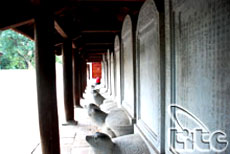 This was announced at the fourth general meeting of UNESCO’s Memory of the World Committee for Asia/Pacific in Macau, China, on March 9, said the Hanoi People’s Committee.
This was announced at the fourth general meeting of UNESCO’s Memory of the World Committee for Asia/Pacific in Macau, China, on March 9, said the Hanoi People’s Committee.
The UNESCO recognition is an important event for the capital city of Hanoi on the threshold of its 1,000th birthday.
The 82 stone steles are carved with the names of 2,313 doctors who
passed the court examinations between 1442 and 1779 (some material
recorded the period between 1484 and 1514) under the Early Le, Mac and
Late Le dynasties.
The steles which bear the names of Trang Nguyen, Bang Nhan, Tham Hoa,
Hoang Giap (the first, second, third and fourth winning categories at
the royal competition) sit on top of stone turtles.
The steles are different from those in other Asian countries, including China, which influenced Vietnamese feudal education.
They are mainly rectangular parallelepipes (a polyhedron consisting
of six faces that are parallelograms) while the Chinese have varied
forms, including square parallelepipes and cylinders.
The Temple of Literature was founded in 1070 as a Confucian temple.
Parts of the complex date to the earliest period, although much of the
architecture dates from the Ly (1010-1225) and Tran (1225-1400)
dynasties.
In 1076, Vietnam’s first university, the Quoc Tu Giam or Imperial Academy, was established within the temple to educate bureaucrats, nobles, royalty and the elite.
The university functioned from 1076 to 1779. The doctor laureate
tests were extremely difficult, so few students passed. Each year, the
names of those who did were engraved on the steles.